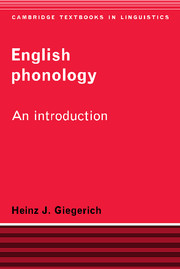Book contents
- Frontmatter
- Contents
- Preface
- 1 Speech sounds and their production
- 2 Towards a sound system for English: consonant phonemes
- 3 Some vowel systems of English
- 4 Phonological features, part 1: the classification of English vowel phonemes
- 5 Phonological features, part 2: the consonant system
- 6 Syllables
- 7 Word stress
- 8 Phonetic representations: the realisations of phonemes
- 9 Phrases, sentences and the phonology of connected speech
- 10 Representations and derivations
- References
- Index
9 - Phrases, sentences and the phonology of connected speech
Published online by Cambridge University Press: 05 June 2012
- Frontmatter
- Contents
- Preface
- 1 Speech sounds and their production
- 2 Towards a sound system for English: consonant phonemes
- 3 Some vowel systems of English
- 4 Phonological features, part 1: the classification of English vowel phonemes
- 5 Phonological features, part 2: the consonant system
- 6 Syllables
- 7 Word stress
- 8 Phonetic representations: the realisations of phonemes
- 9 Phrases, sentences and the phonology of connected speech
- 10 Representations and derivations
- References
- Index
Summary
In the preceding chapter our discussion began to undergo a shift in focus which it is now time to acknowledge, as well as to take further: we have begun to deal with ‘real-life’ speech events by noting, for example, that the operation of allophonic rules is not in principle confined to single words but typically ignores word boundaries (or any other kinds of nonphonological information). We also noted in passing that the implementation of such rules may depend on tempo and other speech-style variables. Up until then our approach had been essentially word-based in that we used single words, enunciated with optimal clarity and at a fairly slow tempo as ‘citation forms’, for the establishment of (segmental) phonemic contrasts as well as for the statements of generalisations regarding syllabification and stress.
Attempting to take the realities of speech more seriously than we have done so far, we shall in this chapter widen the scope of our enquiry in two ways: by studying the phonology of linguistic units larger than words, and by acknowledging the fact that citation forms are a form of speech that is, to say the least, somewhat idealised. We shall first look at phonological structures that give rise to phrasal and compound stress patterns such as ,black 'bird and 'black,bird respectively; and then we shall study other aspects of the phonology of larger-than-word units, such as the rhythmic patterning found in connected speech.
- Type
- Chapter
- Information
- English PhonologyAn Introduction, pp. 249 - 290Publisher: Cambridge University PressPrint publication year: 1992



